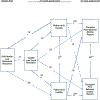Parenting in the Context of the Child: Genetic and Social Processes
- PMID: 37070594
- PMCID: PMC10329459
- DOI: 10.1111/mono.12460
Parenting in the Context of the Child: Genetic and Social Processes
Abstract
The focus on the role of parenting in child development has a long-standing history. When measures of parenting precede changes in child development, researchers typically infer a causal role of parenting practices and attitudes on child development. However, this research is usually conducted with parents raising their own biological offspring. Such research designs cannot account for the effects of genes that are common to parents and children, nor for genetically influenced traits in children that influence how they are parented and how parenting affects them. The aim of this monograph is to provide a clearer view of parenting by synthesizing findings from the Early Growth and Development Study (EGDS). EGDS is a longitudinal study of adopted children, their birth parents, and their rearing parents studied across infancy and childhood. Families (N = 561) were recruited in the United States through adoption agencies between 2000 and 2010. Data collection began when adoptees were 9 months old (males = 57.2%; White 54.5%, Black 13.2%, Hispanic/Latinx 13.4%, Multiracial 17.8%, other 1.1%). The median child age at adoption placement was 2 days (M = 5.58, SD = 11.32). Adoptive parents were predominantly in their 30s, White, and coming from upper-middle- or upper-class backgrounds with high educational attainment (a mode at 4-year college or graduate degree). Most adoptive parents were heterosexual couples, and were married at the beginning of the project. The birth parent sample was more racially and ethnically diverse, but the majority (70%) were White. At the beginning of the study, most birth mothers and fathers were in their 20s, with a mode of educational attainment at high school degree, and few of them were married. We have been following these family members over time, assessing their genetic influences, prenatal environment, rearing environment, and child development. Controlling for effects of genes common to parents and children, we confirmed some previously reported associations between parenting, parent psychopathology, and marital adjustment in relation to child problematic and prosocial behavior. We also observed effects of children's heritable characteristics, characteristics thought to be transmitted from parent to child by genetic means, on their parents and how those effects contributed to subsequent child development. For example, we found that genetically influenced child impulsivity and social withdrawal both elicited harsh parenting, whereas a genetically influenced sunny disposition elicited parental warmth. We found numerous instances of children's genetically influenced characteristics that enhanced positive parental influences on child development or that protected them from harsh parenting. Integrating our findings, we propose a new, genetically informed process model of parenting. We posit that parents implicitly or explicitly detect genetically influenced liabilities and assets in their children. We also suggest future research into factors such as marital adjustment, that favor parents responding with appropriate protection or enhancement. Our findings illustrate a productive use of genetic information in prevention research: helping parents respond effectively to a profile of child strengths and challenges rather than using genetic information simply to identify some children unresponsive to current preventive interventions.
© 2023 The Authors. Monographs of the Society for Research in Child Development published by Wiley Periodicals LLC on behalf of Society for Research in Child Development.
Figures



























Similar articles
-
Family pediatrics: report of the Task Force on the Family.Pediatrics. 2003 Jun;111(6 Pt 2):1541-71. Pediatrics. 2003. PMID: 12777595
-
Biological and rearing mother influences on child ADHD symptoms: revisiting the developmental interface between nature and nurture.J Child Psychol Psychiatry. 2013 Oct;54(10):1038-46. doi: 10.1111/jcpp.12100. J Child Psychol Psychiatry. 2013. PMID: 24007415 Free PMC article.
-
The Early Growth and Development Study: A Dual-Family Adoption Study from Birth Through Adolescence.Twin Res Hum Genet. 2019 Dec;22(6):716-727. doi: 10.1017/thg.2019.66. Epub 2019 Sep 17. Twin Res Hum Genet. 2019. PMID: 31526412 Free PMC article.
-
Family environmental factors influencing the developing behavioral controls of food intake and childhood overweight.Pediatr Clin North Am. 2001 Aug;48(4):893-907. doi: 10.1016/s0031-3955(05)70347-3. Pediatr Clin North Am. 2001. PMID: 11494642 Review.
-
[Homosexual parenthood and child development: present data].Encephale. 2012 Feb;38(1):10-5. doi: 10.1016/j.encep.2011.05.005. Epub 2011 Jul 5. Encephale. 2012. PMID: 22381718 Review. French.
Cited by
-
Influence of early childhood parental hostility and socioeconomic stress on children's internalizing symptom trajectories from childhood to adolescence.Front Psychiatry. 2024 Apr 17;15:1325506. doi: 10.3389/fpsyt.2024.1325506. eCollection 2024. Front Psychiatry. 2024. PMID: 38694000 Free PMC article.
-
Intergenerational transmission of comorbid internalizing and externalizing psychopathology at age 11: Evidence from an adoption design for general transmission of comorbidity rather than homotypic transmission.Dev Psychopathol. 2025 Aug;37(3):1125-1138. doi: 10.1017/S0954579424000968. Epub 2024 Oct 4. Dev Psychopathol. 2025. PMID: 39363878 Free PMC article.
-
How growing up without siblings affects the adult brain and behaviour in the CHIMGEN cohort.Nat Hum Behav. 2025 May;9(5):1005-1022. doi: 10.1038/s41562-025-02142-4. Epub 2025 Mar 31. Nat Hum Behav. 2025. PMID: 40164915
-
Genetic and environment influences on childhood victimization: a systematic review and meta-analysis.Mol Psychiatry. 2025 May;30(5):2228-2238. doi: 10.1038/s41380-024-02868-z. Epub 2024 Dec 11. Mol Psychiatry. 2025. PMID: 39663379 Free PMC article.
-
Lability in parent-child warmth and hostility and adolescent externalizing behaviors.Dev Psychol. 2025 Sep;61(9):1739-1755. doi: 10.1037/dev0001886. Epub 2024 Oct 31. Dev Psychol. 2025. PMID: 39480302
References
-
- Achenbach TM (1992). Manual for the Child Behavior Checklist/2–3 and 1992 profile Burlington, VT: University of Vermont Department of Psychiatry.
-
- Ackerman NW (1958). The psychodynamics of family life New York: Basic Books.
Publication types
MeSH terms
Grants and funding
LinkOut - more resources
Full Text Sources
Medical

